From the sea to the mountains, from natural wonders to historic monuments, there are many landmarks in North Carolina to discover. The state in the USA’s southeast is the 28th largest and 9th-largest population. Bordered by the Atlantic Ocean, Virginia, Georgia, South Carolina and Tennessee, with many natural features shared between the states, North Carolina has many state attractions that share a common history and geography with its neighbours yet remain unique to the state.
North Carolina is packed with historic sites and national historical landmarks that tell stories about the state’s fascinating role in forming the United States. Many of these beautiful buildings are listed on the national register of historic places and are famous landmarks in North Carolina to see on your next trip.
Contents
- 21 North Carolina Landmarks
- Landmarks in Charlotte
- Natural Landmarks in North Carolina
- Historic Landmarks in North Carolina
- 9- Linn Cove Viaduct
- 10- USS North Carolina
- 11- North Carolina State House
- 12- Cape Hatteras Lighthouse
- 13- Duke University
- 14- Biltmore Estate
- 15- Tryon Palace
- 16- Bellamy Mansion
- 17- Ann and Jim Goodnight Museum Park
- 18- Benton Battlefield
- 19- Bennett Place
- 20- Fort Anderson
- 21- The Wright Brothers National Memorial
21 North Carolina Landmarks
Landmarks in Charlotte
1- Metalmorphosis

Metalmorphosis is a contemporary public sculpture created from 40 bits of steel organised in seven segments.
The sections of the mirrored sculpture independently rotate 360 degrees, and the mouth is a fountain that sports water into a surrounding pool.
When the segments are in alignment, the sculpture takes on the form of a giant head.
The artwork by David Cerny is unique because it combines art and engineering.
The segments are motorised and controlled via the internet to form a dynamic showpiece that changes from a human head with gaping holes where the eyes and mouth should be into a form out of this world.
According to Cerny, the sculpture is a self-portrait of the artist’s psyche.
It could well be part of Černý’s iconoclastic artistic temperament that caused him to falsify his biography for the media.
Metamorphosis Statue is in Whitehall Technology Park at 3701 Arco Corporate Dr, Charlotte.
2- Bank America Stadium

The Bank of America Stadium is a 75,525-seat, privately-financed football stadium designed for the Carolina Panthers in 1996.
The Panthers are an American football team that competes in the National Football League.
The stadium in Charlotte serves as the headquarters for the football team, but it also has training facilities and practice fields.
The impressive stadium’s entry has soaring arches and towers at the entrances, clad in building materials that accent the Panthers black, silver and blue team colours.
Archways of oaks leading to the stadium are beautiful to see.
There are beautifully manicured gardens, and escalator bays whisk fans into the stadium with high-tech scoreboards, state-of-the-art sound, high-definition video boards.
151 suites have fully retractable windows and three rows of seating.
Carolina Panthers is at 800 South Mint Street, Charlotte.
Also read:
- 12 National Parks In North Carolina
- 21 North Carolina Landmarks
- 20 North Carolina Beaches
- 20 Things To Do In Cherokee
- 20 Things To Do In Fayetteville NC
- 20 Things To Do In Winston Salem
- 20 Things To Do In Charlotte NC
- 20 Day Trips From Charlotte
- 20 Things To Do In Raleigh NC
- 20 Things To Do In Atlantic Beach
- 20 Things To Do In Hickory NC
- 20 Things To Do In Concord
- 20 Things To Do In Cary
- 20 Things To Do In Beaufort
- 20 North Carolina State Parks
- 20 North Carolina Cities
- 20 Islands In North Carolina
- 20 Things To Do In Asheville
- 20 Things To Do In Oak Island
- 15 Things North Carolina Is Famous For
- 20 Things To Do In Duck
- 8 National Parks In South Carolina
- 20 South Carolina Landmarks
- 20 South Carolina Beaches
- 20 South Carolina Islands
- 20 South Carolina Cities
- 20 Things To Do In Florence SC
- 20 State Parks in South Carolina
- 20 Things To Do In Myrtle Beach
- 20 Things To Do In Charleston
- 20 Things To Do In Columbia SC
- 20 Things To Do In Spartanburg
- 20 Things To Do In Greenville
- 15 Things South Carolina If Famous For
Natural Landmarks in North Carolina
3- Sliding Rock Falls
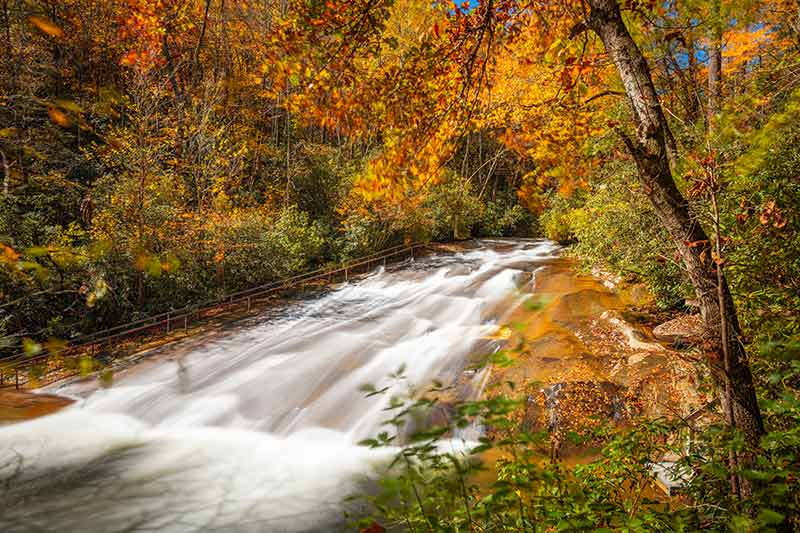
Sliding Rock Falls is one of the unique waterfalls in North Carolina and a fun place to visit.
The waterfall near Brevard earned its name because visitors can slide 60ft down the waterfall into an eight-foot deep plunge pool at the bottom.
The broad and smooth natural rock waterfall on Looking Glass Creek in the Pisgah National Forest is extremely popular, and there are two observation platforms to enjoy a view of the falls.
When there’s heavy rainfall, Sliding Rock may close as the water level might be too high to slide.
Sliding Rock Falls is 40 miles (55-minute drive) from Asheville in Pisgah National Forest, Transylvania Country.
4- Chimney Rock
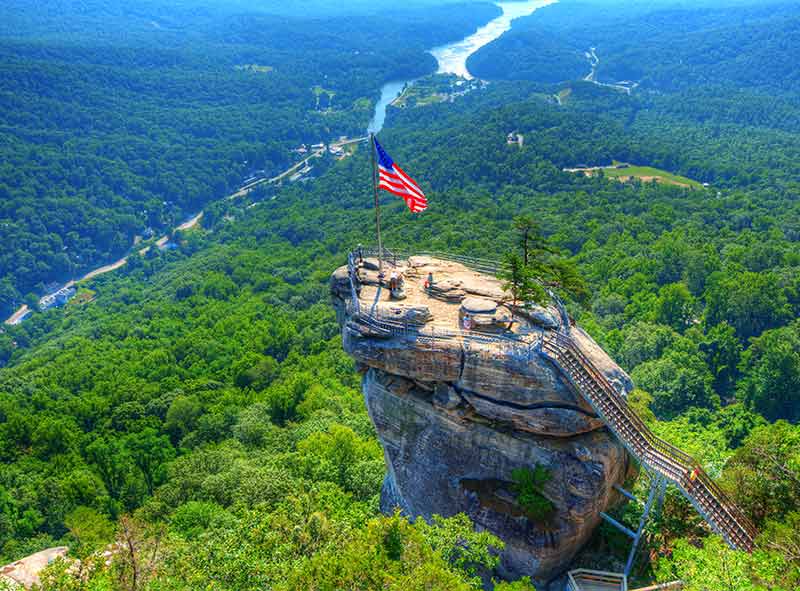
Chimney Rock is a large granite outcrop above the village of the same name in Chimney Rock State Park and a must-see natural attraction.
This 535-million-year-old monolith is one of the famous landmarks in North Carolina and has fantastic views.
From the top of the rock, the panoramic views include Lake Lure and Hickory Nut Gorge.
You can hike up the rock or take the elevator and walk the remaining 44 steps.
Chimney Rock sits 2,280 feet above sea level and has starred in movies such as Firestarter and the Last of the Mohicans.
In the Last of the Mohicans, the final scenes were filmed in the park and included a fight scene at the top of Hickory Nut Falls while the park’s entrance gate and bridge featured in Firestarter.
Chimney Rock is at 431 Main St, Chimney Rock.
5- Crowders Mountain
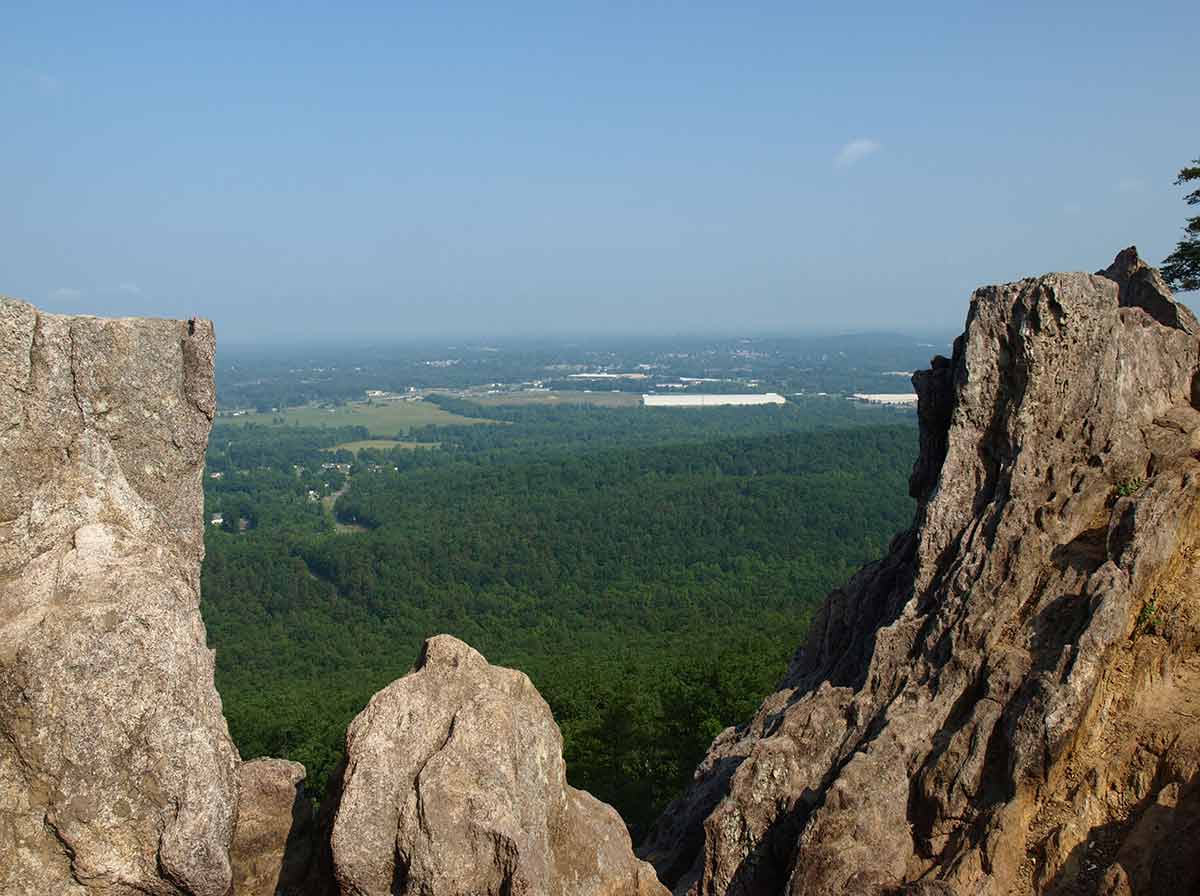
The Pinnacle and Crowders Mountain are two peaks with towering cliffs and stunning views.
There are 11 trails of varying levels, and rock climbing and backcountry camping are popular pastimes.
Before European settlers arrived, buffalo and elk grazed the natural grasslands, and the peaks marked the boundary between the hunting lands of two Indian tribes, the Catawba and Cherokee.
80,000 settlers came to the area from the north by 1775, following a treaty that allowed white settlers west to the Blue Ridge Mountains.
Crowders Mountain is covered in a mature climax forest of hardwoods, such as Chestnut Oak, shrubs, pines, maple and American beech.
Spring is the best season to see flowering dogwood, mountain laurel and Rhododendron.
Sparrow Springs access visitor centre is at 522 Park Office Lane, Kings Mountain.
6- Grandfather Mountain
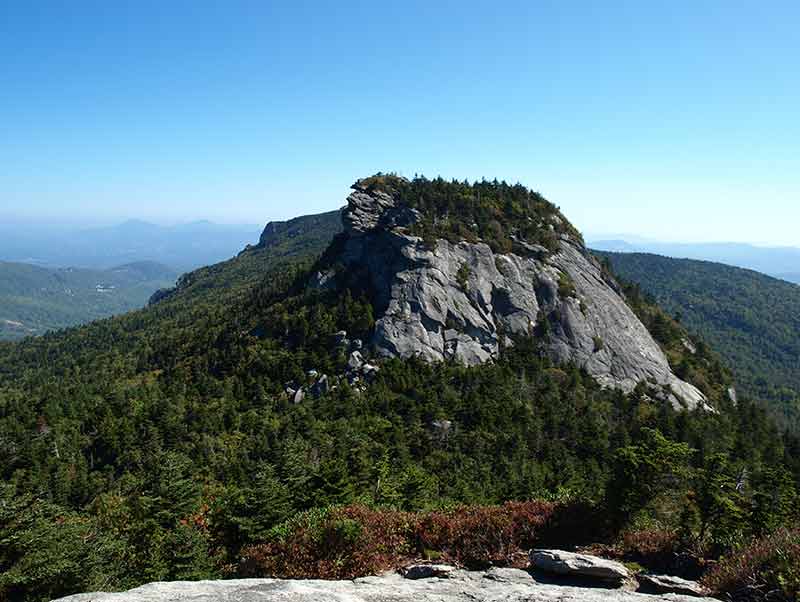
The 5,946 ft Grandfather Mountain near Linville is about 300 million years old, with some rock formations dating back 1.2 billion years.
The mountain is a succession of sandstone, arkosic conglomerate and siltstone bedded in with rhyolite and basalt.
The area around the mountain has an impressive ecological diversity, with a range of plants, animals, climate and terrain.
Grandfather Mountain is part of the United Nations’ network of Biosphere Reserves.
It’s unique because there are 72 endangered species and 16 ecologic communities.
Grandfather Mountain is at 2050 Blowing Rock Highway, Linville.
7- Clingman’s Dome

Clingman’s Dome is a soaring mountain in the Great Smoky Mountains National Park straddling Tennessee and North Carolina.
The mountain is 6,643 ft high and the highest point in the Great Smoky Mountains National Park.
It’s part of the Copperhill geological formation formed 560 million years ago.
The formation consists mainly of a coarse-grained conglomerate with layers of schist and has 20ft (6m) beds of micaceous quartzite.
The Appalachian Trail passes it in the north.
The Clingmans Dome Observation Tower has a spectacular 360° view of the Smoky Mountains and is open all year round.
Clingmans Dome Tower is at Clingmans Dome Road.
8- Mount Mitchell
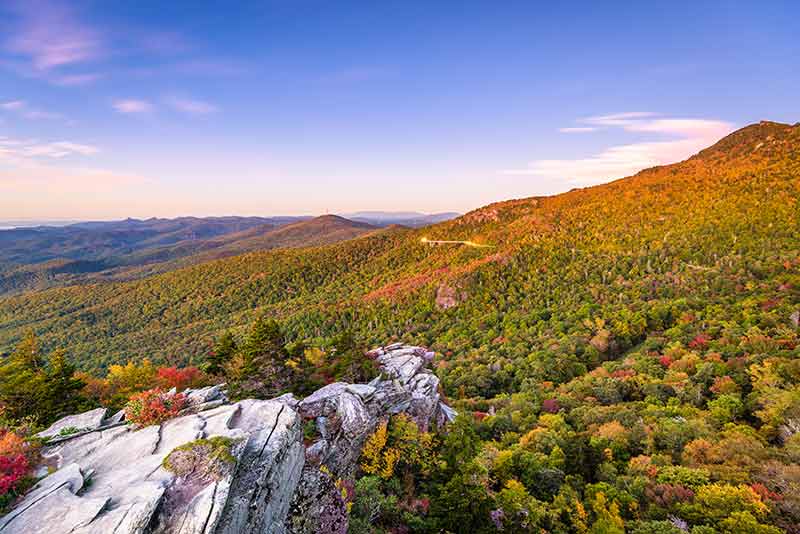
Mount Mitchell is part of the Blue Ridge and the Appalachian Mountains’ highest peak in North Carolina.
Located near Burnsville in Yancey County, Mt. Mitchell is 6,684 feet (2,037 m), the observation deck offers spectacular views, and there’s a restaurant open from spring to fall.
You can hike to the top of Mount Mitchell or drive to the observation deck, a museum where you can learn cultural and natural history.
Hiking trails pass through balsam forests, where rare plants, wildlife, and 91 types of birds are found.
Nature formed the range more than a billion years ago, and the peaks were rounded by erosion.
Mount Mitchell became North Carolina’s first state park in 1915.
Mount Mitchell is 35 miles northeast of Asheville.
Also read:
- 20 USA Landmarks
- 23 Canada Landmarks
- 22 Ohio Landmarks
- 21 Arizona Landmarks
- 21 Minnesota Landmarks
- 21 Oregon Landmarks
- 21 Illinois Landmarks
- 21 Colorado Landmarks
- 21 Georgia Landmarks
- 21 Michigan Landmarks
- 23 Los Angeles Landmarks
- 21 Washington Landmarks
- 21 Maryland Landmarks
- 20 Manitoba Landmarks
- 20 Kansas Landmarks
- 21 New Mexico Landmarks
- 20 Idaho Landmarks
- 20 Montana Landmarks
- 20 Oklahoma Landmarks
- 21 Wisconsin Landmarks
- 20 Tennessee Landmarks
- 21 Iowa Landmarks
- 20 Alaska Landmarks
- 20 Miami Landmarks
- 21 West Virginia Landmarks
- 21 Kentucky Landmarks
- 20 Louisiana Landmarks
- 21 Arkansas Landmarks
- 20 Cincinnati Landmarks
- 20 San Antonio Landmarks
- 25 Indiana Landmarks
- 21 New York Landmarks
- 20 Texas Landmarks
- 21 Boston Landmarks
- 20 Florida Landmarks
- 20 Hawaii Landmarks
- 5 South Dakota Landmarks
- 21 Pennsylvania Landmarks
- 23 New Jersey Landmarks
- 21 Virginia Landmarks
- 21 North Carolina Landmarks
- 21 Utah Landmarks
- 21 Nevada Landmarks
- 20 Massachusetts Landmarks
- 20 Washington DC Landmarks
- 20 Vermont Landmarks
- 20 Nebraska Landmarks
- 20 North Dakota Landmarks
- 21 Missouri Landmarks
- 20 Rhode Island Landmarks
- 21 Maine Landmarks
- 21 Connecticut Landmarks
- 20 San Diego Landmarks
- 20 Landmarks In South Carolina
- 20 Mississippi Landmarks
- 20 Las Vegas Landmarks
- 20 Dallas Landmarks
- 20 Houston Landmarks
- 20 Seattle Landmarks
Historic Landmarks in North Carolina
9- Linn Cove Viaduct
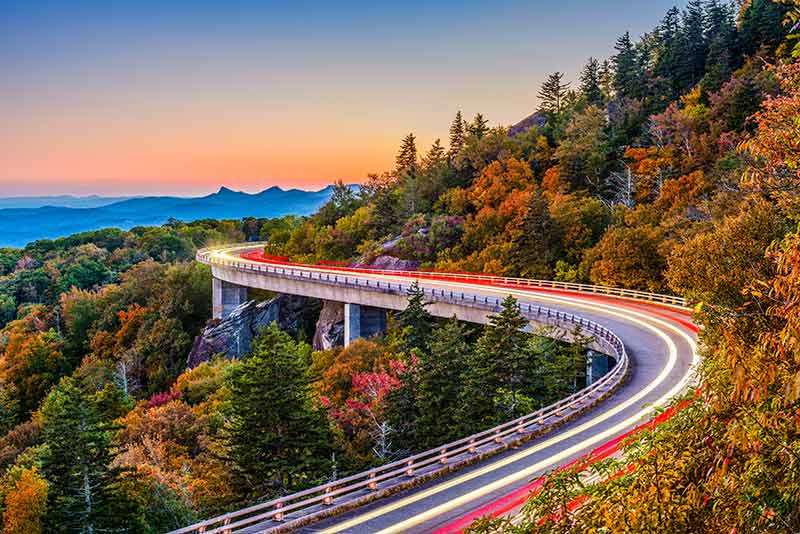
The Linn Cove Viaduct is a 1,243 ft engineering landmark (according to the American Society of Civil Engineers) and the final section of the Blue Ridge Parkway, which began its construction in 1935.
The bridge curves around Grandfather Mountain and was completed in 1983.
The viaduct sits on seven piers and built while keeping heavy construction equipment off the ground.
The build was done by connecting 153 segments individually using a crane, and the only work done on the ground involved drilling the footings for the piers.
The viaduct won the 1984 President’s Design Award as well as other design awards.
Linn Cove Visitor Centre is at Blue Ridge Pkwy, Linville.
10- USS North Carolina
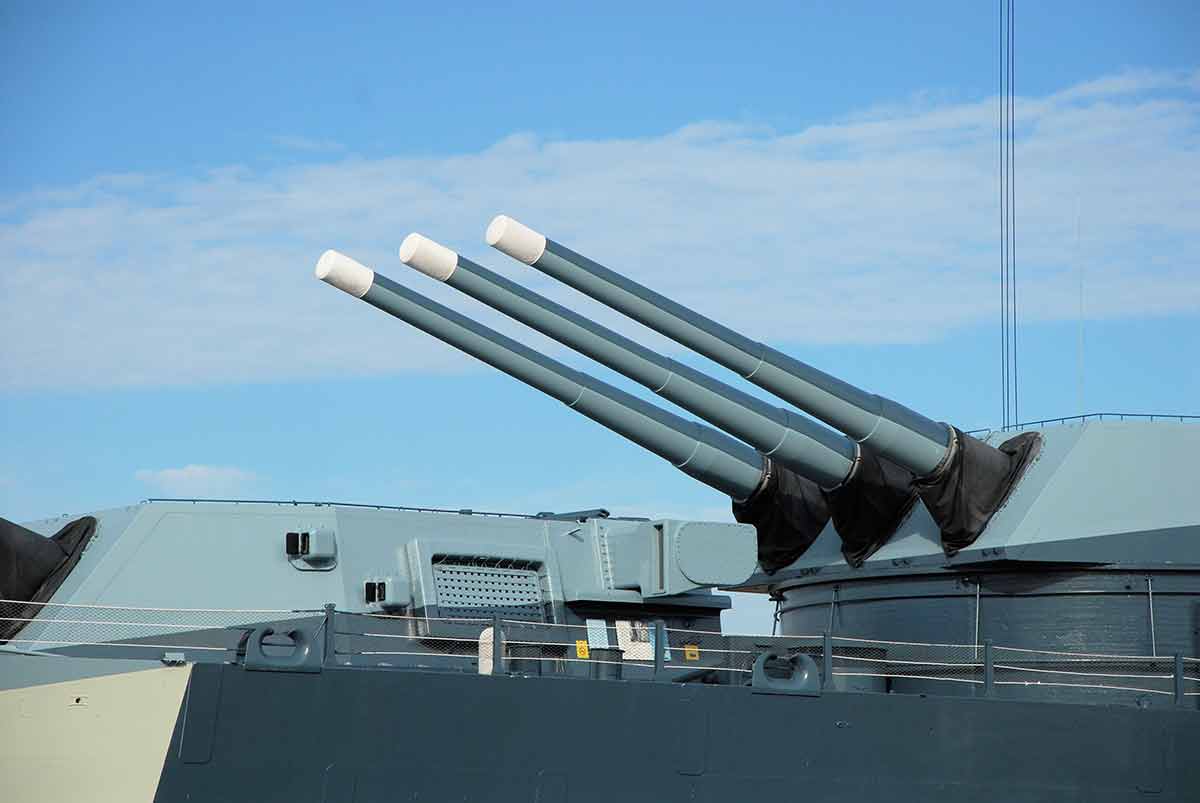
The USS North Carolina is a historic landmark of North Carolina and was the first of 10 battleships to be part of the US fleet.
The ship is moored on the Wilmington River near the city; it’s one of the historic sites that is a must-visit for history buffs.
The battleship was a state-of-the-art weapon when it was commissioned in 1941, armed with nine 45 calibre guns in three turrets and 20 by 38 calibre guns in ten twin mounts.
The USS North Carolina was home to 2195 enlisted men, including 144 commissioned officers.
The ship performed impressively in the Pacific during World War II and was decommissioned in 1947.
It was brought to its home state in 1958 to save it from being scrapped, and in 1962, USS North Carolina became a landmark to the state’s World War II veterans.
11,000 North Carolinians perished during this war.
The USS North Carolina is at 1 Battleship Rd NE, Wilmington.
11- North Carolina State House
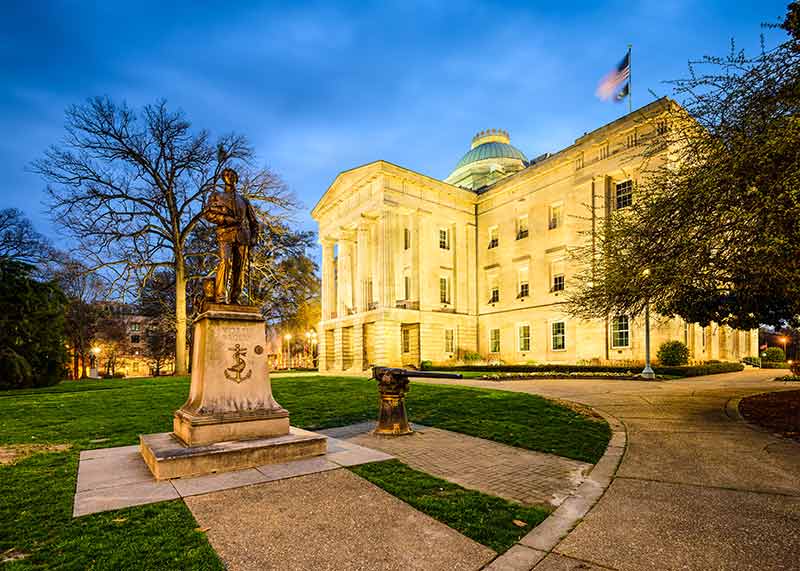
During colonial times, North Carolina’s governors did not operate from a fixed capital city but lived in their own homes while the Assembly moved from place to place.
They held meetings in private homes and courthouses until North Carolina’s State House was constructed.
North Carolina State House is the state capitol building for North Carolina and renovated in neoclassical style in the 19th century.
First occupied in 1794, the State House was renovated, and a third floor, more wings and a domed rotunda were later constructed.
The rotunda housed Italian sculptor Antonio Canova’s statue of George Washington, but when the State House burned down in 1831, the statue was damaged beyond repair.
This building has been the operational capital headquarters for the state and building of the state since 1840 and housed the Governor’s office, the Supreme Court, and the General Assembly’s chambers.
It’s one of the historic sites that will help visitors understand the state’s history.
North Carolina Statehouse is at One East Edenton Street, Raleigh.
12- Cape Hatteras Lighthouse
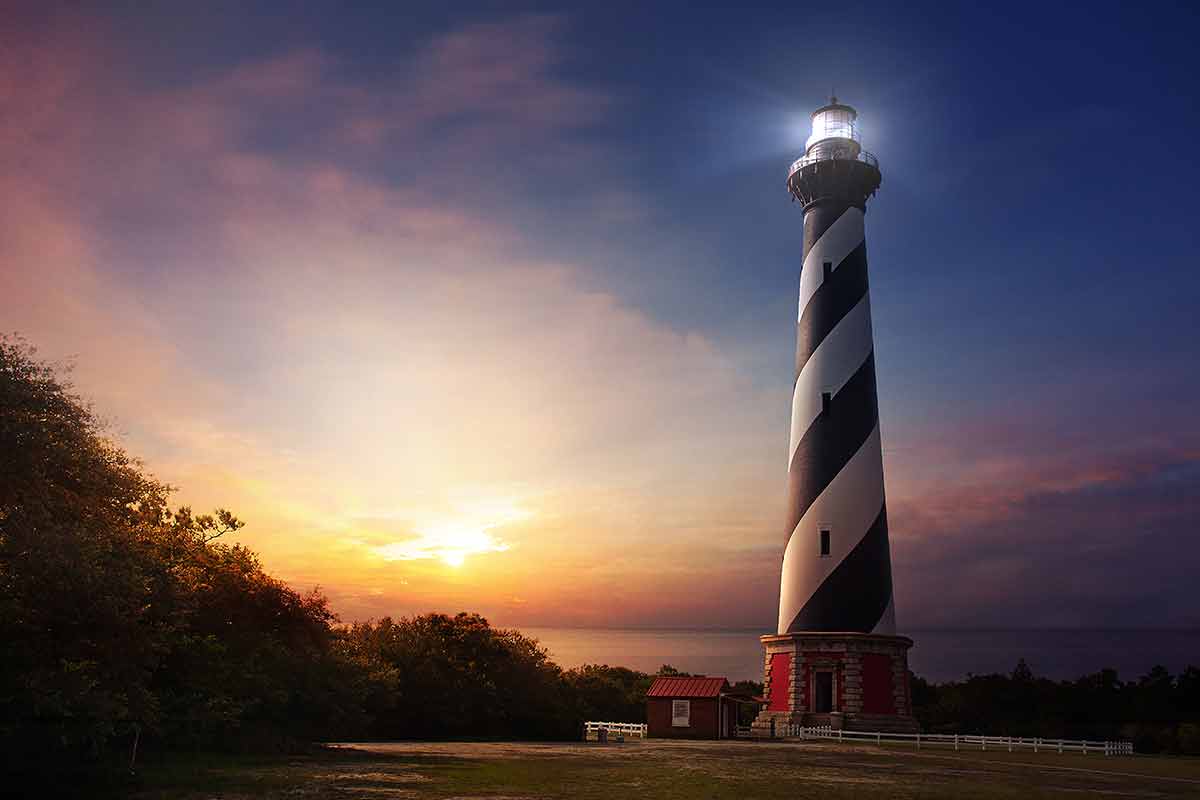
One of the most famous North Carolina landmarks is also the tallest lighthouse in the state and the tallest brick lighthouse in the USA.
It’s one of the few lighthouses that stands out is because of its black-and-white striped pattern.
The cape is located on the bend in Hatteras Island, one of North Carolina’s barrier islands.
The islands have windswept beaches with impressive dunes, marshes and forests.
The lighthouse is a beacon that provides warnings to ships and one of the most hazardous parts of the Atlantic Coast where the Gulf Stream meets the Virginia Drift, creating a current that forces southbound ships into the treacherous Diamond Shoals sandbar.
The area is famous for shipwrecks and is known as the ‘Graveyard of the Atlantic.’
Cape Hatteras Lighthouse is located at 46379 Lighthouse Road, Buxton.
13- Duke University
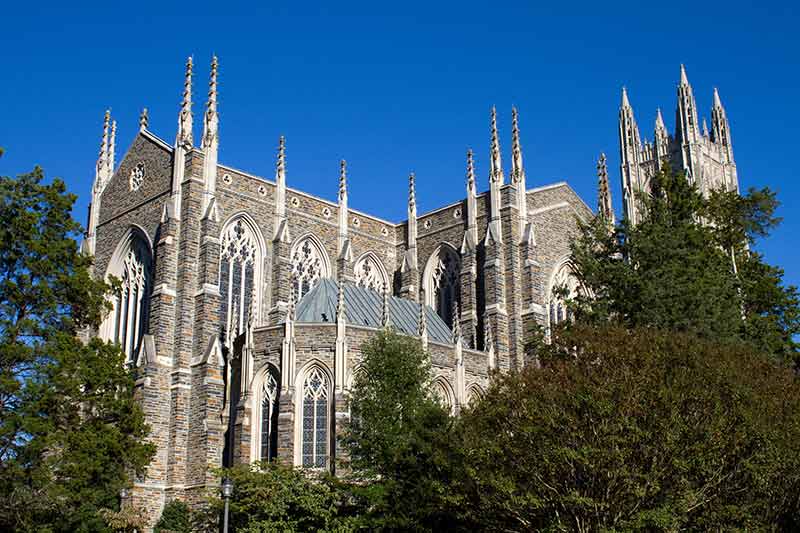
In 1892, Duke University, which Quakers founded in Trinity in 1838, moved to Durham.
The university is a private research university set in an architecturally impressive Tudoresque building that fills an entire city block.
The university’s graduate programs are well-regarded for business, engineering, law and medicine.
Duke University Chapel is an ecumenical Christian chapel connected to the United Methodist Church.
The English Gothic architectural style is one of the last major Gothic projects built in the USA.
Built from stone from Duke Quarry near Hillsborough, the chapel’s lectern, balustrade and pulpit are built from Indiana limestone.
At the same time, the vaults and walls of the nave were constructed from Guastavino tile.
Duke University Chapel is at 401 Chapel Dr, Durham.
14- Biltmore Estate
In 1895, industrialist George Vanderbilt built a 250-room chateau as a vacation home for him and his wife, Edith.
Biltmore Estate is an 8000-acre estate that has stunning gardens designed by famous landscape architect Frederick Law Olmsted.
Biltmore House is a grand mansion with 33 bedrooms, indoor and outdoor pools, a library, bowling alley, banquet hall and 65 fireplaces!
Guests can do a self-guided tour to admire the lavish rooms and discover the history of the Vanderbilt family through well-placed displays of art, furniture and vintage clothing.
The house has been a National Historic Landmark in North Carolina since 1963.
Biltmore Estate is at 1 Lodge Street, Asheville.
15- Tryon Palace
Built-in 1776, Tryon Palace was the seat of the US government in the early days and the first official Governor’s Palace.
The palace was the administrative headquarters and official residence of the British governors of North Carolina until 1775, and many balls and official events were held here.
Governor William Tryon commissioned English architect John Hawks to design the Palace to resemble a fashionable Georgian-style country house.
It was once thought of as one of the finest public buildings in the colonies and has a rich history.
The first governor to live in it was Governor Tryon, his wife and daughter.
Josiah Martin moved in when he took the position as the second governor, only to flee when the American Revolution began.
The palace was taken over by the General Assembly, who met here to create an independent state.
A significant event was held on 21 April 1791, when a dinner and dance was held in honour of George Washington.
Raleigh became Virginia’s state capital in 1794.
Tryon Palace is at 529 S Front St, New Bern.
For more amazing European Landmarks, read:
- 30 Spain Landmarks
- 20 Switzerland Landmarks
- 22 Germany Landmarks
- 35 London Landmarks
- 30 France Landmarks
- 20 Italy Landmarks
- 20 Greece Landmarks
- 20 Russia Landmarks
- 20 Scotland Landmarks
- 20 Ireland Landmarks
- 21 Wales Landmarks
- 20 Turkey Landmarks
- 20 England Landmarks
- 20 Hungary Landmarks
- 21 Romania Landmarks
- 20 Ukraine Landmarks
- 20 Athens Landmarks
- 20 Rome Landmarks
- 20 England Landmarks
- 20 Portugal Landmarks
- 20 Poland Landmarks
- 20 Iceland Landmarks
- 20 Bulgaria Landmarks
- 21 Croatia Landmarks
- 20 Bulgaria Landmarks
- 20 Austria Landmarks
- 21 Finland Landmarks
- 20 Sweden Landmarks
- 20 Denmark Landmarks
- 20 Belgium Landmarks
- 20 Netherlands Landmarks
- 20 Barcelona Landmarks
- 21 Czech Republic Landmarks
- 20 Landmarks in Paris
- 20 Landmarks in Liverpool
- 10 Istanbul Landmarks
16- Bellamy Mansion
The handsome Bellamy Mansion is a Neoclassical Green and Italianate building built between 1859 and 1861.
Bellamy Mansion was initially constructed as a private residence but was used by Federal Troops during the war between the north and the south.
After a fire in 1972, the mansion was rebuilt, and today it’s a museum with historical, artistic and design displays.
Bellamy Mansion is at 503 Market St, Wilmington.
17- Ann and Jim Goodnight Museum Park
Art and nature prove to be striking bedfellows at Goodnight Museum Park, the largest museum park in the USA.
It has 164 acres of dog-friendly trails that meander past sunflower fields, stunning sculptures, ponds and gardens.
Visitors can enjoy a roll call of artists including Auguste Rodin, Joan Miró and Barbara Kruger.
Gyre is a famous steel and concrete ring sculpture created by local artist Thomas Sayre.
Goodnight Museum Park is at North Carolina Museum of Art, 1800 Blue Ridge Rd, Raleigh.
18- Benton Battlefield
The Battle of Bentonville was fought from 19 to 21 March 1865 and is significant because it was the last full-scale battle of the Civil War where a Confederate army mounted a tactical offensive.
This major battle was the largest battle fought in North Carolina and the only significant attempt to defeat the massive Union army of General William T. Sherman.
Robert E. Lee’s Army of Northern Virginia surrendered to Grant three weeks after the fighting ended at Bentonville.
Although the battlefield is one of the most famous historic sites, most of it is privately owned; however, the state is acquiring more key property through the Department of Cultural Resources.
Benton Battlefield is at 5466 Harper House Rd, Four Oaks.
19- Bennett Place
Bennet Place is a simple farmhouse where Confederate General Johnston met with Union General Sherman in April 1865 and one of the most famous historical sites.
The two leaders met at Bennett Place, where the south signed surrender papers for southern armies in the Carolinas, Georgia and Florida.
You can visit James Bennett’s reconstructed farmhouse and walk through the lifestyle of an ordinary Southern farmer during the Civil War.
Bennett Place is at 4409 Bennett Memorial Rd, Durham.
20- Fort Anderson
Fort Anderson was a major pre-Revolutionary port on North Carolina’s Cape Fear River and an impressive national historic landmark.
During the Civil War, Fort Anderson was built on top of the site of the colonial settlement of Brunswick.
It served as a defence for the Cape Fear River.
The fort’s earthen batteries were used as platforms and shields for the Confederate cannons.
Bombproof shelters were constructed below the earthworks and used as safe places by troops.
The fort’s purpose was to hinder Union ships’ movement and serve as a dropping off point for blockade runners that made it to the mouth of the Cape Fear River.
Fort Anderson is at 8884 St. Philip’s Rd. SE, Winnabow.
21- The Wright Brothers National Memorial
Wright Brothers National Memorial is a monument in North Carolina that pays homage to the first successful powered flights in a machine heavier than air.
Wilbur and Orville Wright Orville believed Kill Devil Hills was the best location to conduct experiments in flying because of the giant sand dunes in the area.
They improved their designs in Dayton, Ohio and Europe but did the first two-person flights at Kitty Hawk in 1908.
The memorial is a 60-foot granite monument commemorating the achievement of the Wright brothers.
The Wright Brothers National Memorial is at 1000 N Croatan Hwy, Kill Devil Hills.


Plan Your Trip

Rent A Car – Find the best car rental rates at Discover Cars. They compare car hire companies to provide you with the best deal right now.

Find A Hotel – If you’re curious about this article and are looking for somewhere to stay, take a look at these amazing hotels.





